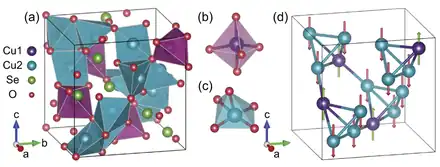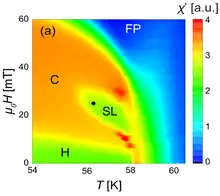Copper oxide selenite
Copper oxide selenite is an inorganic compound with the chemical formula Cu2OSeO3. It is an electrically insulating, piezoelectric and piezomagnetic material, which becomes a ferrimagnet upon cooling below 58 K. As of 2021, Cu2OSeO3 is the only insulating material that hosts magnetic skyrmions.[1]
| Identifiers | |
|---|---|
3D model (JSmol) |
|
| |
| |
| Properties | |
| Cu2OSeO3 | |
| Molar mass | 270.059 g/mol |
| Appearance | Green dodecahedral crystals[1] |
| Density | 5.1 g/cm3[2] |
| Band gap | 2.5 eV[3] |
| Thermal conductivity | 400 W/(m·K) (9 K)[4] |
Refractive index (nD) |
3.8 (100 K, 1 kHz)[2] |
| Structure[2] | |
| Cubic | |
| P213, #198, cP56 | |
a = 0.8924 nm | |
Formula units (Z) |
8 |
Except where otherwise noted, data are given for materials in their standard state (at 25 °C [77 °F], 100 kPa).
Infobox references | |
Synthesis

Cu2OSeO3 polycrystals can be grown by heating a 2:1 molar mixture of CuO and SeO2 powders at 600 °C for 12 hours in vacuum. They can be converted into olive-green single crystals ca. 4 mm in size by chemical vapor transport. NH4Cl is used as the transport agent; it sublimes at 340 °C, yielding NH3 and HCl gases.[1]
Structure
Cu2OSeO3 crystals have a cubic, distorted pyrochlore structure built by Cu4O and SeO3 units. The spins on three Cu2+ ions in each tetrahedron (Cu1 sites) are aligned, while the Cu2 spin is facing in the opposite direction, resulting in a ferrimagnetic order. The helical spin and skyrmion textures emerge at low magnetic fields due to the Dzyaloshinskii-Moriya interaction.[1]
Properties
Cu2OSeO3 is a ferrimagnet, and all its properties below the Curie temperature strongly depend on magnetic field. With increasing field, its spin texture changes from helical stripes to conical stripes or skyrmion lattice, and then to a "field polarized", i.e., ferrimagnetic alignment. Thermal conductivity peaks around 9 K with a value of ca. 400 W/(m·K).[4] The magnetization damping constant is 1×10−4 at 5 K. This value is only 4 times larger than that of yttrium iron garnet, which has the lowest magnetization damping value among all materials. This property is advantageous for high-frequency electronic applications, as it results in low current-induced heat.[5]
References
- Panella, Jessica R.; Trump, Benjamin A.; Marcus, Guy G.; McQueen, Tyrel M. (2017). "Seeded Chemical Vapor Transport Growth of Cu2OSeO3". Crystal Growth & Design. 17 (9): 4944–4948. arXiv:1706.02411. doi:10.1021/acs.cgd.7b00879. S2CID 103302936.
- Bos, Jan-Willem G.; Colin, Claire V.; Palstra, Thomas T. M. (2008). "Magnetoelectric coupling in the cubic ferrimagnet Cu2OSeO3". Physical Review B. 78 (9): 094416. arXiv:0808.3955. Bibcode:2008PhRvB..78i4416B. doi:10.1103/PhysRevB.78.094416. S2CID 56431702.
- Versteeg, R. B.; Vergara, I.; Schäfer, S. D.; Bischoff, D.; Aqeel, A.; Palstra, T. T. M.; Grüninger, M.; van Loosdrecht, P. H. M. (2016). "Optically probed symmetry breaking in the chiral magnet Cu2OSeO3". Physical Review B. 94 (9): 094409. arXiv:1605.01900. Bibcode:2016PhRvB..94i4409V. doi:10.1103/PhysRevB.94.094409. S2CID 118390265.
- Prasai, N.; Akopyan, A.; Trump, B. A.; Marcus, G. G.; Huang, S. X.; McQueen, T. M.; Cohn, J. L. (2019). "Spin phases of the helimagnetic insulator Cu2OSeO3 probed by magnon heat conduction". Physical Review B. 99 (2): 020403. Bibcode:2019PhRvB..99b0403P. doi:10.1103/PhysRevB.99.020403. S2CID 119506811.
- Stasinopoulos, I.; Weichselbaumer, S.; Bauer, A.; Waizner, J.; Berger, H.; Maendl, S.; Garst, M.; Pfleiderer, C.; Grundler, D. (2017). "Low spin wave damping in the insulating chiral magnet Cu2OSeO3". Applied Physics Letters. 111 (3): 032408. arXiv:1705.03416. Bibcode:2017ApPhL.111c2408S. doi:10.1063/1.4995240. S2CID 13560805.
